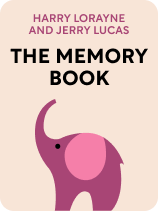

This article is an excerpt from the Shortform book guide to "The Memory Book" by Harry Lorayne and Jerry Lucas. Shortform has the world's best summaries and analyses of books you should be reading.
Like this article? Sign up for a free trial here.
What’s a foundational memory? Can you deliberately create one? Why are concrete things easier to remember than abstract things?
The Memory Book is a classic book that can help you put to memory and recall all kinds of information. Authors Harry Lorayne and Jerry Lucas share the basic memory principles that underpin the strategies they recommend.
Keep reading to learn about these five principles of memory.
Basic Memory Principles
Lorayne and Lucas discuss five basic memory principles that guide all of their memorization techniques. Let’s look at each principle in detail.
Principle #1: To Remember Something, Create a Foundational Memory of It
The authors argue that when you say you’ve “forgotten something,” it’s typically because you never actually absorbed the information in the first place. To remember something later on, you need to first create a foundational memory of it.
(Shortform note: Some research suggests that we can improve our ability to absorb information and create memories by practicing meditation. For instance, one 2013 study found that two weeks of training in mindfulness meditation improved participants’ ability to recall information by minimizing distracting thoughts. These findings suggest that having fewer mental distractions allows us to better process and learn information we receive from our senses. Additionally, it may improve our ability to store information in short- and long-term memory. Learning, processing, and storing are all necessary skills to create the foundational memories Lorayne and Lucas discuss.)
Principle #2: Create Foundational Memories Through Close Observation
To create a foundational memory, pay close attention to what you’re trying to remember and mentally absorb the information (instead of just looking at it). If the thing you want to remember is related to an action—for instance, if you want to remember where you chain your bike—this means actively thinking about the action you’re completing while you’re doing it, even if it’s small.
For example, have you ever opened your phone to look at the time, then realized that you couldn’t remember what you saw when you closed your phone a few seconds later? To remember the time, deliberately notice the numbers on the screen by actively thinking something like, “I’m opening my phone to look at the time on my lock screen. I’m going to look at the numbers and nothing else. The numbers are 1, 3, 4, and 7, meaning it’s 13:47.” This deliberate attention to your actions trains your brain to catalog the information you observe, helping you retrieve it later.
| Increasing Your Powers of Observation If you’re looking to improve your powers of observation and strengthen your ability to create foundational memories, practice is essential. As with other skills, the more you practice observation, the better you’ll be at it and the more naturally it’ll come to you. These strategies can serve as a starting point for your observational practice: Visiting a new place. This helps you practice observation by increasing your awareness of unfamiliar details. Places where close observation is encouraged, such as museums, are a good place to start. Journaling. Sit down somewhere and record what you see, what you hear, who you talk to, and so on. Try sketching some of the things you see. Recording the world around you provides good practice by encouraging you to pay attention to everything around you. |
Principle #3: Visualizing Is Akin to Seeing
According to the authors, visualization—mentally picturing the thing you want to remember—is a great tool for memory creation. Sight is deeply connected to memory. So, when you see information, you’re more likely to retain it.
(Shortform note: Sight’s interconnectedness with memory may relate to this sense’s general importance in our brain. In Brain Rules, John Medina argues that vision dominates the other senses—interpreting visual information is an energy-intensive process and about half of the brain is devoted to vision. This means sight shapes our perception of the world and influences our learning and memory more than any other sense. If we receive contradictory information from multiple senses, the visual input usually dominates our perception of the information, thus dictating what we retain.)
Further, some studies suggest that visualizing an image in your mind activates electrical signals in your brain that are nearly identical to signals activated when your eyes perceive a physical image. Therefore, just imagining you can see something strengthens it in your memory as much as actually seeing it.
| Helping People “See” With Sound Picturing images in your mind’s eye may not be the only way to artificially activate the brain signals associated with seeing an image. Some studies suggest that people who are blind from birth can learn to recognize images using sound. Researchers used devices to scan images and reinterpret them as soundscapes for congenitally blind participants to listen to. After training, participants were able to recognize faces, everyday objects, and even words based on the soundscapes. Additionally, when they listened to the soundscapes, parts of their visual cortex activated that normally activate when people see the same images. Prior to these findings, activation of the visual cortex was thought to be impossible in people who are born blind. |
Principle #4: Tangible Information Is Easier to Remember
The authors assert that it’s easier to remember information (such as a word) that has a concrete meaning than information that’s abstract and intangible. This applies when using visualization techniques, as something has to have clear, concrete meaning for you to picture it. For example, names are often more difficult to remember than other words because they don’t have any specific image or meaning associated with them. You likely can’t form a picture of a name like “Schaeffer” by itself, but you can picture a word that has tangible meaning, like “horse.”
(Shortform note: Supporting the argument that tangible information is easier to remember, Moonwalking With Einstein author Joshua Foer suggests incorporating as many of your senses as you can into your mental representations of things you want to remember. He states that the more senses you incorporate, the more cues you have to remind you of the memorized information. If applicable, imagine how something looks, smells, sounds, feels, and tastes. In keeping with Lorayne and Lucas’s advice, including more sensory information will also make your mental representations more tangible.)
Principle #5: It’s Easier to Remember Strange Things
Finally, Lorayne and Lucas state that you’re more likely to remember information (especially an image) if it’s novel, illogical, or strange. In contrast, it’s easy to forget images and information that are ordinary or common. For example, you’ll likely more readily recall a sensational, unusual culinary dish you ate years ago—such as rhubarb pizza—than whatever ordinary meal you had for lunch last week. Likewise, you’d be more likely to remember a woman named Mustard than a woman named Pam.
(Shortform note: Some experts argue that forgetting ordinary, everyday information isn’t just an inconvenience or a quirk of memory—it’s an important function of a healthy brain. Since we’re constantly exposed to new information, our brains need a way to filter out unnecessary details to make room for novel, useful information. We’re more likely to forget ordinary information—like whatever we ate for lunch last week—because our brain already has memories stored about the ordinary thing, and more memories of it will take up space that we’d use for new information.)

———End of Preview———
Like what you just read? Read the rest of the world's best book summary and analysis of Harry Lorayne and Jerry Lucas's "The Memory Book" at Shortform.
Here's what you'll find in our full The Memory Book summary:
- How to improve your memorization skills and recall any kind of information
- Techniques for remembering sequences of information
- How to picture and remember abstract information






